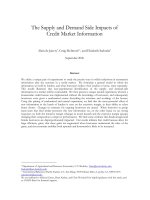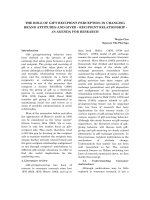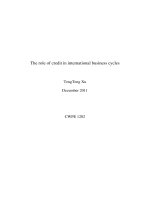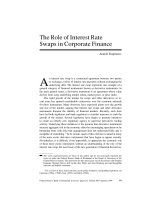SMEs finance and bankruptcies: The role of credit guarantee schemes in the UK
Bạn đang xem bản rút gọn của tài liệu. Xem và tải ngay bản đầy đủ của tài liệu tại đây (738.1 KB, 16 trang )
Journal of Applied Finance & Banking, vol. 8, no. 3, 2018, 1-16
ISSN: 1792-6580 (print version), 1792-6599 (online)
Scienpress Ltd, 2018
SMEs finance and bankruptcies:
The role of credit guarantee schemes in the UK
Paolo Agnese1, Manuel Rizzo2 and Gianfranco A. Vento3
Abstract
With reference to consideration on the future of credit guarantees in the world, it
may be interesting to analyze the UK framework of guarantee schemes in favour
of SMEs, where there are no private guarantee providers and where there is a
substantial public monopoly. In particular, in this paper it emerges that among the
countries examined by the OECD, the country where the credit guarantees are
least widespread is the United Kingdom. However, the trend in bankruptcies
recorded in recent years by British firms is better than the median of the other
countries considered. Results from the regression analysis show that among years
of operation where EFG has been introduced, possibly this kind of government
loan guarantees scheme for SMEs played a minor role, compared to
macroeconomic indicators as GDP, in dealing with SMEs bankruptcies.
JEL classification numbers: G21, G28, G29
Keywords: Guarantee schemes, Credit, Bankruptcies
1 Introduction
1
2
2
LUISS Guido Carli University Rome, Italy.
Sapienza University of Rome, Italy.
Regent’s University London, UK.
Article Info: Received: December 13, 2017. Revised : January 27, 2018
Published online : May 1, 2018
2
Paolo Agnese, Manuel Rizzo and Gianfranco A. Vento
The recent financial crisis started in 2007 highlighted significant difficulties for
Small and Medium Enterprises (SMEs) in accessing to credit from financial
institutions. These difficulties have also been amplified the regulatory response to
the crisis, known as ‘Basel III’, which is going to impose an increase in capital
requirements for banks, a shift towards more expensive regulatory capital items as
well as the requirement for banks to increase more liquid assets and longer-term
sources of funding.
These difficulties have also affected British SMEs. In order to mitigate the credit
crunch faced by British SMEs, public programs have been put in place either
before or after the financial crisis. These programs are addressed mostly to
facilitate the access to credit by the provision of public guarantees.
In the light of above, the paper aims at critically reviewing the functioning of the
credit guarantee schemes used during the crisis in United Kingdom, in order to
highlight possible strengths and weaknesses.
A regression analysis will also be performed on data related to British SMEs
bankruptcies, in order to give insight on the role the present schemes play in
favour of SMEs.
The paper is structured as follows. Section 2 presents some key figures about
SMEs in UK. Section 3 points out the role of policy makers in SME finance,
whereas section 4 highlights the functioning of the Enterprise Finance Guarantee
(EFG) and how it has evolved over time. Section 5 deals with the impact of
government loan guarantees for SMEs on bankruptcies in the UK. Last, section 6
offers some conclusions.
2 Small and Medium Enterprises in the UK: Some Evidence
In the United Kingdom the small and medium business sector represents a
significant portion of private businesses. This is determined by the sheer number
of SMEs, the level of employment they provide and their annual turnover with
respect to the total private enterprises.
This is proven by the statistics elaborated by the Department for Business, Energy
& Industrial Strategy (BEIS), which periodically publishes the “Business
Population Estimates for the UK and Regions” regarding UK Business Population.
The above mentioned publication reports that at the beginning of 2017, there were
an estimated 5.7 million UK private sector businesses, with an estimated annual
turnover of over £3.7 trillion. It is not surprising that almost all of these businesses
in the UK were small and medium-sized enterprises (SME) 4 , accounting for
4
A small business is defined as a business with 0-49 employees, a medium-sized business is one
with 50-249 employees, and a large business is one with 250 or more employees. Small and
medium-sized enterprises (SMEs) are defined as businesses with 0-249 employees. See
Department for Business, Energy & Industrial Strategy (2017).
SMEs finance and bankruptcies: the role of credit guarantee schemes in the UK
3
99.9% of all private sector businesses and had an estimated annual turnover of
£1.9 trillion (51% of all private sector turnover in the UK). Almost all private
businesses (99.3%) were small; about 0.6% were medium whereas only 0.1%
were large (see table 1).
Table 1: Estimated number of businesses in the UK private sector and their
associated employment and turnover by size of business start of 2017
1. Total turnover figures exclude financial and insurance activities where turnover is not available
on a comparable basis.
2: “With no employees” includes sole proprietorships and partnerships with only the self-employed
owner-manager(s), and companies with a single employee, who are assumed to be directors.
Source: Department for Business, Energy & Industrial Strategy (2017).
Further interesting findings have emerged from the statistics published by the
BEIS. We can see, for example, that of the above-mentioned 5.7 million
businesses active in the UK at the beginning of 2017, about 5 million were in
England. Most of these businesses were to be found in London and the South East
of England and in both of these areas there were one third of all private businesses
in the UK. London and the South East also had the highest business density rates
in the UK, based on the size of the resident adult population (see figure 1).
4
Paolo Agnese, Manuel Rizzo and Gianfranco A. Vento
Figure 1: Number of businesses and business density rate in the private sector by
English region and UK country, start of 2017
Source: Department for Business, Energy & Industrial Strategy (2017).
3 The Policy Makers’ Role in SME Finance
Several empirical studies confirmed that there is a structural failure problem for
viable SMEs financing, particularly in recent years characterised by periods of
economic downturn, when they have difficulties in accessing bank funds due to
insufficient guarantees or track records (Department for Business, Innovation &
Skills, 2010, 2009).
Although the recent financial crisis made the lack of funding for British SME
more urgent, the problem is not new. An analysis of this issue was proposed
decades ago by the Wilson Committee which in 1979 stated “competition between
banks…was insufficiently effective to ensure that viable small businesses always
had the necessary access to sufficient funds on reasonable terms”.
As a response to this, in 1981 the British government introduced a guarantee
scheme named “Small Firms Loan Guarantee” (SFLG) in favour of profitable
SMEs which would not have been otherwise able to obtain credit through
conventional lending due to insufficient guarantees and/or track record.
However, this scheme, in use for three decades, in recent years has proven to be
inadequate in supporting the growing demand for credit from viable SMEs. This is
mainly due to the serious international economic and financial crisis as well as to
SMEs finance and bankruptcies: the role of credit guarantee schemes in the UK
5
the regulatory response to the financial crisis – known as “Basel III” – which
requires banks to increase the amount of regulatory capital, to improve its quality
and to increase the volume of liquid assets that banks have to hold.
Consequently, in order to avoid the credit crunch caused by the crisis and a more
stringent regulatory framework, in January 2009 the British government introduced
a further measure in favour of SMEs facing difficulties in credit access: the
Enterprise Finance Guarantee (EFG) substituted the previous Small Firms Loan
Guarantee.
It is worth stating that both schemes (SFLG and EFG) were created to give financial
aid to viable SMEs that were not able to access bank credit due to their lack of
adequate guarantees and/or track record, and not as a substitute to conventional
bank loans. SFLG and EFG are thus an addition to the conventional bank loan and
not a substitute.
Both schemes (SFLG and EFG) are very similar, but the EFG compared to the
SFLG is open to a larger number of viable SMEs, as it can count on greater financial
resources. This facilitates even further, compared to the past, the concession of bank
loans to SMEs, and it is in response to the credit crunch triggered by the
economic-financial crisis.
The sum of the loans backed by the SFLG and the EFG however, is relatively low
compared to that of bank loans granted to SMEs. In fact, loans granted by these
schemes account for no more than 1%-2% of the total number of loans to SMEs
(Department for Business, Innovation & Skills (2009, 2008).
4 The Enterprise Finance Guarantee (EFG)
As mentioned previously, in January 2009 the Small Firms Loan Guarantee was
substituted by another government scheme to guarantee and support viable SMEs
in the UK, the Enterprise Finance Guarantee (EFG). The Scheme is managed by
British Business Financial Services, a wholly-owned subsidiary of British
Business Bank plc, but remains on the balance sheet of the government
Department for Business, Energy & Industrial Strategy (BEIS)5.
The EFG was created to assist viable SMEs operating within the UK in a
particularly difficult economic-financial period. In fact, it’s aim was to facilitate
the transfer of bank credit to those SMEs unable to access conventional loans –
due to insufficient or no guarantees and/or track record – but that can prove to
have the ability to repay the credit, in full, over time.
As before mentioned, all decisions regarding whether a business is eligible or not
5
The British Business Bank is a development bank wholly owned by HM Government. It delivers
most of the government’s programmes aimed at supporting SME access to finance through a range
of financial facilities. For further clarifications regarding the EFG scheme, visit the website of the
British Business Bank, .
6
Paolo Agnese, Manuel Rizzo and Gianfranco A. Vento
for the EFG loan scheme, are solely made by accredited lenders6. The lender, in
determining whether or not the request to borrow from the Scheme is possible,
must first evaluate a whole range of qualitative and quantitative information
normally required by the borrower: details of the purpose of the loan and details of
other borrowings of the business; historical and prospective business information
(business plan).
After that, the lender has to evaluate if the borrower satisfies the following EFG
eligibility criteria:
The borrower must be an SME operating in the UK with an annual
turnover of a maximum of £41 million (if the borrower is part of a group,
the turnover must refer to that of the group);
The loan must be for a minimum period of three months and a maximum
of ten years (exceptions are made for Invoice Finance Guarantee,
Overdraft Guarantee and other revolving facilities, which operate for a
period no longer than three years);
The borrowing proposal must be between a minimum of £1,000 and a
maximum of £1.2 million (for terms beyond 5 years, the maximum loan
amount is capped at £600,000);
The borrower must have inadequate security to meet a lender’s normal
requirements;
The borrower must be in an eligible economic sector. The majority of
economic sectors are eligible with principal exclusions relating to
businesses in the coal industry, and certain aspects of agriculture and
financial services;
The borrower has to be able to confirm that they have not received other
public support or state aid beyond euro 200,000 equivalent over the
previous three years.
Having completed the assessment the lender should be able to confirm or not the
application to the EFG. In fact, a viable SME which applies for an assisted loan
from the scheme is not automatically accepted, nor is there a standardized
procedure to obtain the loan. Therefore, the decisions concerning an application to
the guarantee offered by the EFG – including the decision whether it is
appropriate or not to use it for each loan application – are entirely made by the
participating lenders. In fact, the Department for Business, Energy & Industrial
Strategy (BEIS) does not intervene in the assessment process nor in the
application process.
Through the EFG, the loan can be granted according to various processes, such as:
new term loans; revolving facilities; invoice finance facilities; term loan for debt
6
Currently, there are over 40 participating lenders ranging from the main high street banks to
smaller specialist institutions, some of which have a specific geographic, sectoral or product focus.
The list of lenders is available on British Business Bank website.
SMEs finance and bankruptcies: the role of credit guarantee schemes in the UK
7
consolidation or refinancing; revolving facility refinance; invoice finance
refinance.
The government guarantee offered by the scheme covers 75% of the loan. It is
issued in favour of the lender, not in favour of the borrower. This means it is not
an insurance for the borrower in the event of his inability to repay the loan. As
with any other commercial transaction, the borrower is responsible for repayment
of 100% of the EFG loan. In fact, the 75% guarantee in favour of the lender
doesn’t mean that the borrower is only liable for 25% of the loan. In case of
default, the lender has to follow the standard commercial recovery procedures,
including the realization of any security held and calling upon any personal
guarantees which may have been provided, before they make a claim against the
government guarantee7.
In exchange for government backing the borrower is required to pay other than
the capital sum and interest (plus any commission that may come with the loan), a
premium to cover the cost of the guarantee8. The premium equals 2% yearly of the
loan’s outstanding balance. This premium is calculated and paid for every three
months for the entire duration of the loan9.
An evaluation of the EFG scheme was carried out in 201310. Some of the key
results were, in summary, the following: the vast majority (83%) of users
indicated that they would not have been able to obtain a loan without EFG scheme
(this compares to 70% and 76% found within the 1999 and 2006 evaluations of
previous scheme, the SFLG scheme); businesses receiving finance generated
employment and sales growth comparable to other borrowers, indicating that the
EFG scheme is able to remove the barriers to growth presented by the borrowers
that have inadequate security to meet a lender’s normal requirements (European
Investment Bank, 2015).
Below we report some trends recorded by the EFG scheme since the year of its
establishment.
Figure 2 illustrates the sum (in £m) of loans offered and of loans actually granted
thanks to the EFG scheme. It shows that in the first months of the EFG’s activity,
there was a huge demand, which decreased gradually over time. This is likely to
be due to the bank credit’s tension on the market and the resulting credit crunch
caused by the international crisis. These tensions were particularly felt during the
years 2009-2010, while in the following years they slowly eased off as confirmed
7
The only exception from normal commercial practice is that the lender is expressly prohibited
from taking a charge over a principal private residence as security for an EFG loan.
8
The interest rates and any likely commissions to be added on to guaranteed EFG loans are set by
the accredited lenders.
9
The premium, in effect, only partially covers the cost of the guarantee. The premium in question
is not the same as an insurance premium.
10
In total, 1,399 SME were surveyed including 500 EFG supported businesses and 899 unassisted
businesses. The survey tracked SME performance for the period 2009-2012 (Department for
Business Innovation & Skills, 2013).
8
Paolo Agnese, Manuel Rizzo and Gianfranco A. Vento
by the decreasing trend in the demand for the government scheme.
300
Value of Loans Offered (£m)
250
Value of Loans Drawn (£m)
200
150
100
50
0
2009
2010
2011
2012
2013
2014
2015
2016
Figure 2: Value of Loans Offered (£m) & Value of Loans Drawn (£m), 2009-2016
Source: British Business Bank, “Enterprise Finance Guarantee Quarterly Statistics”, 2017.
Conversely, figure 3 shows the total sum (in £m) of loans offered and of loans
actually granted through the EFG divided between all the various regions in the
UK. The EFG, like that of the SFLG, covers all regions of the UK. Looking at the
figure in question, it is possible to note how the geographical distribution of the
value of loans offered and the value of loans drawn is roughly in line with the
geographical distribution of the SMEs (see figure 1, already commented before).
SMEs finance and bankruptcies: the role of credit guarantee schemes in the UK
Value of Loans Offered (£m)
9
Value of Loans Drawn (£m)
600
500
400
300
200
100
0
Figure 3: Value of Loans Offered (£m) & Value of Loans Drawn (£m) 2009-2016,
Regions
Source: British Business Bank, “Enterprise Finance Guarantee Quarterly Statistics”, 2017.
Finally, figure 4 shows the total sum (in £m) of loans offered and of the loans
actually granted through the EFG subdivided by “Age of business”. The figure
shows that both start-up SMEs (present on the market for no longer than three
months) and mature SMEs (present on the market for at least five years) are most
supported by the government scheme. This could be due to several reasons, among
which, for example, lack of track record on behalf of the younger SMEs and
insufficient guarantees available on behalf of the older SMEs.
10
Paolo Agnese, Manuel Rizzo and Gianfranco A. Vento
Value of Loans Offered (£m)
Value of Loans Drawn (£m)
1.400
1.200
1.000
800
600
400
200
0
Figure 4: Value of Loans Offered (£m) & Value of Loans Drawn (£m), 2009-2016,
Age of Business
Source: British Business Bank, “Enterprise Finance Guarantee Quarterly Statistics”, 2017.
5 The impact of government loan guarantees for SMEs on
bankruptcies in the UK
A natural question related to EFG aims at evaluating the effectiveness of such
scheme. Namely, as long as these kind of government loan guarantees schemes are
introduced to support SMEs in critical periods, it is worth asking whether EFG
effectively provides a valuable help in preventing SMEs bankruptcies. Such a
question is common to many advanced countries which introduced government
loan guarantees schemes for SMEs, in particular in a delicate period of time
started with financial crisis.
SMEs finance and bankruptcies: the role of credit guarantee schemes in the UK
11
Table 2: Trend of bankruptcies in the UK and in the rest of the world, 2009-2015
(Year-on-year growth rates, as a percentage)
Countries
UK
Median
2009
13,99
13,07
2010
-13,76
-2,56
2011
2,70
-0,70
2012
-4,16
2,14
2013
-10,90
-5,54
2014
-6,73
-6,73
2015
-9,50
-9,47
Mean
-4,05
-1,40
Note: “Median” is calculated on the percentage of year-on-year growth rates of the following
countries: Austria, Belgium, Canada, Czech Republic, Denmark, Estonia, Finland, France, Greece,
Hungary, Israel, Italy, Japan, Korea, Netherlands, Russian Federation, Slovak Republic, Spain,
Turkey, United Kingdom, United States. Data on Mexico are not available.
Source: OECD, “Financing SMEs and Entrepreneurs 2017: An OECD Scoreboard”, OECD
Publishing, Paris, 2017.
Table 2, for example, shows the trend of year-on-year growth rate of SMEs
bankruptcies (as a percentage) for the UK and for the median of a large selection
of countries adopting government loan guarantees schemes, between 2009 and
2015. It shows that in this time period values for UK are generally lower than
considered median, which may indicate a positive effect of EFG with respect to
these countries, also because 2009 is the year in which this scheme was
introduced.
However, characteristics and values of such schemes differ, sometimes
considerably, from country to country, especially if we take into account the
specific features of each nation, so comparison should be performed with caution.
With reference in particular to the value (measured as a percentage of GDP) of the
schemes in question measured in year 2015, credit guarantees are more widely
used in Greece (about 8%), followed by Japan (around 5%). In most other
countries (for example, Spain, Italy and France), the value of credit guarantees
represents considerably less than 1% of GDP. Among the countries observed, the
nation for which these credit guarantees is least widespread (0.002%) is the United
Kingdom (see Figure 5).
12
Paolo Agnese, Manuel Rizzo and Gianfranco A. Vento
Figure 5: Share of government loan guarantees for SMEs, 2015
(as a percentage of GDP)
Note: Countries marked with an asterisk make use of 2014 data. The median value refers to all
depicted countries in both graphs.
Source: OECD, “Financing SMEs and Entrepreneurs 2017: An OECD Scoreboard”, OECD
Publishing, Paris, 2017, p. 55.
This could suggest that SMEs bankruptcies in UK may be influenced also by
macroeconomic factors. This topic has been widely studied in literature, with
reference to companies in general and not only SMEs. Many proposals have
considered many macroeconomic indicators, most of which related to GDP and
business cycle, as possible factors influencing probability of default of companies.
For example, Koopman et al. (2009) concluded that defaults can be strongly
affected by macroeconomic variables as GDP-growth and business cycle. Qu
(2008) studied the relationship between default probability and macroeconomic
indicators in many nations, arguing that behavior could be different from country
to country. Jiménez and Mencía (2009) focused on economic situation in Spain,
asserting that exposure at default is higher during recessions than during economic
upturns.
In order to gain indications on possible implications of SMEs bankruptcies in the
UK we shall conduct a linear regression analysis limited to available data, in
which the response variable is the number of SMEs bankruptcies, and explanatory
variables are GDP and government guaranteed loans for SMEs, in the period
2009-2015. Data employed in the analysis and results are summarized in Table 3.
SMEs finance and bankruptcies: the role of credit guarantee schemes in the UK
13
Table 3: Regression analysis for SMEs bankruptcies in the UK
Data
Variables
Number of SMEs Bankruptcies
Government guaranteed loans (in GBP million)
GDP (in GBP billion)
Regression analysis results
Coefficients
Intercept
Government guaranteed loans
GDP
Goodness of fit
R-squared
p-value of F statistics
2009
25038
626
1519,459
2010
21592
529
1572,4
2011
22175
326
1628,3
2012
21252
288
1675
2013
18936
337
1739,6
2014
17661
298
1822,5
2015
15984
226
1872,7
Estimate p-value
63817,16
0.004
-0,00000240000
0.645
-0,00000002517
0.009
0,9424
0,003
Sources:
Data on SMEs bankruptcies: OECD, “Financing SMEs and Entrepreneurs 2017: An
OECD Scoreboard”, OECD Publishing, Paris, 2017.
Data on government guaranteed loans for SMEs: British Business Bank, “Enterprise
Finance Guarantee Quarterly Statistics”, 2017.
Data on GDP: World Bank,
Parameter estimates are substantially small in absolute value, because of very
large values of explanatory variables. There is clear evidence on significance for
parameter “GDP” (p-value=0.009), which does not hold true for “Government
guaranteed loans”. In any case the whole set of parameters is highly significant
(p-value of F statistics equal to 0.003) and adequacy of model is confirmed also by
large value of R squared index.
As far as we have very few data, having EFG only recently been introduced, no
strong statement basing on these results can be made. However a general
suggestion, in perspective of future more in-depth analysis, is that SMEs
bankruptcies could be due to several factors, and possibly government loans
scheme as EFG could be play a minor role, compared to specific macroeconomic
features of the UK.
6 Conclusion
In most advanced and developing countries there is some form of guarantee
schemes in favour of SMEs, even though, obviously, each country has its own
peculiarities in this regard.
In the United Kingdom, too, the SME segment is a very important part of all
private businesses.
In this context there is no mention of “system” of guarantees in favour of SMEs,
but there is essentially only the presence of government guarantee schemes (in the
past the SFLG, currently the EFG) to guarantee loans in favour of British viable
14
Paolo Agnese, Manuel Rizzo and Gianfranco A. Vento
SMEs that are not able to access bank credit due to their lack of adequate
guarantees and/or track record.
An analysis of the characteristics of the UK guarantee schemes has shown,
moreover, that the loans guaranteed by these schemes typically account for no
more than 1%-2% of the total value of the conventional bank loans granted to
British SMEs. Furthermore, it has also emerged that, among the various countries
observed, the country in which the share of government loan guarantee for SMEs
as a percentage of GDP) is less widespread is the United Kingdom, with a
percentage equal to 0.002%.
Results from the regression analysis showed that among years of operation where
EFG has been introduced, possibly this kind of government loan guarantees
scheme for SMEs played a minor role, compared to macroeconomic indicators as
GDP, in dealing with SMEs bankruptcies. As far as we focused on few data, due
to the fact that EFG has been introduced only recently, we can only gain
suggestions on this topic, to be used as a basis for further studies. These latter
could be also devoted to the analysis of government loan guarantee schemes in
other countries, for which more information is available so more precise and
possibly different conclusions could be reached.
References
[1] Berger, A.N., Udell, G.F., “A more complete conceptual framework for SME
finance”, Journal of Banking & Finance, Volume 30, Issue 11, pp.
2945-2966, 2006.
[2] British Business Bank, “Enterprise Finance Guarantee Quarterly Statistics”,
2017.
[3] British Business Bank, “Small Business Finance Markets 2016/17”, 2017.
[4] British Business Bank, “Annual Report and Accounts 2017”, 2017.
[5] British Business Bank, “Enterprise Finance Guarantee (EFG). Scheme
Strategic And Operational Design Review 2015/16”, 2016.
[6] British Business Bank, “Enterprise Finance Guarantee. Application Process
and List of Lenders”, 2014.
[7] British Business Bank, “Enterprise Finance Guarantee. Business Sectors and
Purposes”, 2014.
[8] Cowling M., Siepel J., “Public intervention in UK small firm credit markets:
Value-for-money or waste of scarce resources?”, Technovation, Volume 33,
Issues 8–9, pp. 265-275, 2013.
[9] Cowling M., “The role of loan guarantee schemes in alleviating credit
rationing in the UK”, Journal of Financial Stability, Volume 6, Issue 1, pp.
36-44, 2010.
SMEs finance and bankruptcies: the role of credit guarantee schemes in the UK
15
[10] Department for Business, Energy & Industrial Strategy, “Business Population
Estimates for the UK and Regions 2017”, Statistical release, 30 November
2017.
[11] Department for Business, Innovation & Skills, “BIS Performance Indicators.
Value Enterprise Finance Guarantee funds used by businesses”, 2015.
[12] Department for Business, Innovation & Skills, “Economic Evaluation of The
Enterprise Finance Guarantee (EFG) Scheme”, Report by: Allinson G.,
Robson P. and Stone I., Policy Research Group Durham Business School/St
Chad’s College, 2013.
[13] Department for Business, Innovation & Skills, “SME Access to Finance
Schemes. Measures to support SME growth”, 2013.
[14] Department for Business, Innovation & Skills, “Economic Evaluation of the
Small Firms Loan Guarantee (SFLG) Scheme”, by Cowling M., Institute for
Employment Studies, 2010.
[15] Department for Business, Innovation & Skills, “Early Stage Assessment of
the Impact of the Enterprise Finance Guarantee (EFG) on Recipient Firms”,
by Allinson G., Stone I., Braidford P., Houston M., Policy Research Group
Durham Business School/St Chad’s College, 2009.
[16] Department for Business, Innovation & Skills, “Small Firms Loan Guarantee:
Annual Report for Financial Year 2007/08, 2008.
[17] European Investment Bank, “Using Financial Instruments for SMEs in
England in the 2014-2020 Programming Period. A study in support of the
ex-ante assessment for the deployment of EU resources”, 2015.
[18] Green A., “Credit Guarantee Schemes for Small Enterprises: An Effective
instrument to Promote Private Sector-Led Growth?”, SME Technical
Working Papers Series, Working Paper No. 10, UNIDO, 2003.
[19] IFF Research, “Qualitative Research into the Delivery and Operation of EFG
Loans”, Prepared for The British Business Bank by IFF Research, 2016.
[20] Jiménez, G., Mencía, J., “Modelling the distribution of credit losses with
observable and latent factors”, Journal of Empirical Finance, Volume 16,
Issue 2, pp. 235-253, 2009.
[21] Koopman, S. J., Kräussl, R., Lucas, A. and Monteiro, A. B., “Credit Cycles
and Macro Fundamentals”, Journal of Empirical Finance, Volume 16, Issue
1, pp. 42-54, 2009.
[22] Leone P., Vento G.A. (eds.), Credit Guarantee Institutions and Sme Finance,
Palgrave Macmillan, 2012.
[23] OECD, “Financing SMEs and Entrepreneurs 2017: An OECD Scoreboard”,
OECD Publishing, Paris, 2017.
[24] Page M., “Policy on small firms 1997-2015”, House of Commons Library,
briefing paper no 7363, 2015.
[25] Qu, Y., “Macroeconomic factors and probability of default”, European
Journal of Economics, Finance and Administrative Sciences, 13, 192-215,
2008.
16
Paolo Agnese, Manuel Rizzo and Gianfranco A. Vento
[26] Vento G.A., Agnese P., “The guarantee system in Argentina”, in Leone P.,
Vento G.A. (eds.), Credit Guarantee Institutions and Sme Finance, Palgrave
Macmillan, 2012.
[27] Vento G.A., Agnese P., “Guarantee institutions and credit to Smes: mutual
guarantee societies in Argentina”, in Bancaria n. 1/2011, Bancaria Editrice,
Roma, 2011.









